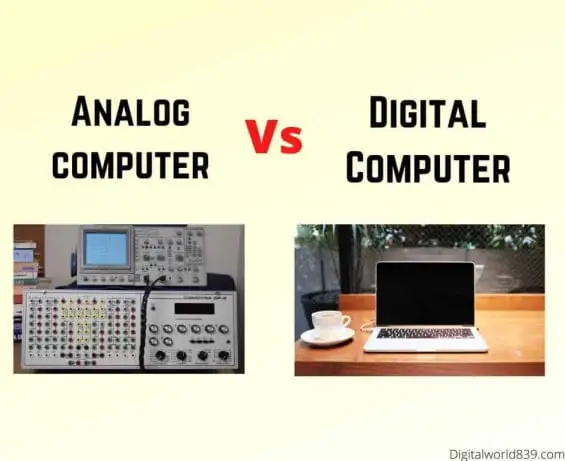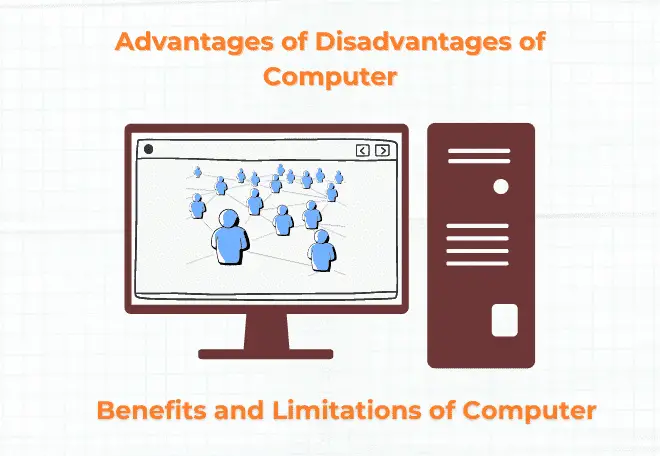We have heard a lot about Digital Computers, but, what is Analog Computer is rarely mentioned. Not because they do not exist, but people think that computers are digital-only. We come across many Analog computer examples, but we hardly notice them as Analog devices.
The basic difference between Analog and Digital Computer is the type of data they process. Analog Computers processes to change their data constantly. Digital Computer processes data in binary code.
In the article, you get to know what is analog computer examples as well as the difference between analog and digital computers.
What is an Analog Computer?
An analog computer is a device that performs tasks using continuous data. Analog devices are used to measure voltage, pressure, electric current, temperature.
These quantities vary continuously while measuring the quantity, such as the temperature of a person which changes consistently. The analog computer is the 1st generation of computers i.e beginning of the computing world.
Analog computers are equipped to measure things rather than countable or check. They are specially designed to measure and perform arithmetic calculations of numbers, where numbers are represented in physical quantities.

In the typical electronic analog computers, the inputs are converted to voltages that can be added or multiplied using specially designed circuit units. Responses are continuously generated for viewing or for conversion into another desired form.
The efficiency of this computer increases, when we get the result of the data in the form of graphs etc. Analog Computers cannot store statistics. They are used in the fields of technology, science, research, engineering, education, etc.
Features of Analog Computer
- An essential feature of analog computers is that the quantities that represent digital data change consistently over time.
- Consequently, analog computers differ from common digital computers, which operate only with numbers, or quantities.
- Analog computers are mostly mechanical or electrical machines that can perform tasks like addition, multiplication, subtraction, and division.
- The output of analog devices can be expressed in the form of graphs drawn on the screen of an oscilloscope or on paper, or an electrical signal used to control the operation of a mechanism.
- The analog machines are designed for specific purposes.
- These are generally used to monitor real-world conditions like Wind, Sound, Movement, Temperature, etc.
- In addition to technical applications (like automatic transmissions and musical synthesizers), analog computers are also used to solve specific computational problems of a practical nature.
Advantages of Analog Computers
The advantageous point of analog devices is that they show the results in a simple or graphical way within a short time. Real-time transformations in a Digital Computer require complex programming and graphical programs, but in analog computers is quite opposite.
Disadvantages of Analog Computers
Less accuracy and lack of versatility are the significant demerits of analog computers. As the accuracy of Analog Computers is limited, It has to be dependent on a number of factors such as spread across circuit parameters, incorrect assembly, wiring problems, etc. External factors like magnetic fields, changes in ambient temperature and pressure, voltage, etc.
Due to the high price of the computer, Analog devices are out of the use of common people, because of the higher prices of computers and bit complex to use and learn. Computerizing data is more expensive than brain visual data processing.
Examples of Analog Computers
For example, you must have seen that when a patient reaches the hospital to check his health. The patient is examined through the analog computer, just like how many temperatures of fever does the patient has, what is the BP of the patient’s body, all such tests are done by the use of Analog Computers or machines.
Famous examples of Analog Computers are planimeters, nomograms, operational amplifiers, mechanical integrators, slide rules, tide pool predators, electric integrators that solve partial differential equations as well as solves algebraic equations.
Other Examples of Analog Computers: Weight measuring machines, Librascope, aircraft weight, and balance computer, mechanical computer, water integrator.
Analog computers are not only used in the scientific field but also in industrial enterprises, Here they have to provide the temperature, voltage, and electric currents on the screen as per the needs.
An example of a modern analog computer is an automatic car transmission. When the torque changes, the fluid pressure in the hydraulic drive also changes, and the nature of this “function” can be changed constructively.
Difference between Analog and Digital Computer
I hope you got what is an analog computer and its examples. Now, uncover the difference between analog and digital computers.

Difference | Analog Computers | Digital Computers |
1. Definition | A computer that uses a continuous signal to process is called an analog computer. | A computer that uses a discrete signal for its operation is called a digital computer. |
2. Output | The output of an analog computer in the form of graphical or voltage signals. | The output of digital devices is in the form of binary numbers. |
3. Working face | Analog Computer transmits the data on a continuous signal. | Digital Computers transmit the data on a discrete signal. |
4. Ability | Analog computer has a limited ability to function as a digital computer. | The Digital system is able to simulate Analog Computer’s behavior. |
5. Speed | Analog computers are slower and less reliable. | Digital computers are high-speed devices that you can rely on. |
6. Usage | Analog computers are used in specific fields such as mechanical engineering and medicine as they are difficult to use. | Digital computers are used around the world as they are quite easy to use digital computers. |
7. Measuring task | This Computer measures Analog Quantity like the voltage, temperature, etc. | Digital computers perform mathematical functions, complex calculations, media streaming, etc. |
8. Accuracy | Analog computers provide accurate computation results. | Digital computers lose precision due to the nature of discrete signals. |
9. Use | These computers are designed for specific operations, mainly used in the field of science. | These computers are designed to use for general purposes, thus can be used in all aspects of life. |
10. Examples | The best example of an analog device is 3 hands wrist watch and oscilloscope (an instrument used to display and analyze the waveform of electronic signals) used by engineers for measurements. | The best example of digital devices are desktops, laptops, smartphones, chromebooks, calculators, a pedometer, (which counts the exact number of steps while walking.) |
FAQs
What is analog computer example?
You must have seen that when a patient reaches the hospital to check his health and is examined through the thermometer (analog computer), just like how many temperatures of fever does the patient has, the BP of the patient’s body, all such tests are done by the use of Analog Computers or machines.
What are the difference between digital and analog computer?
One of the main differences between analog and digital computers is that analog Computer measures Analog quantities like voltage, temperature, etc. While Digital computers perform mathematical functions, complex calculations, media streaming, etc.
What are examples of analog computers?
Examples of Analog Computers are planimeters, nomograms, operational amplifiers, mechanical integrators, slide rules, tide pool predators, electric integrators that solve partial differential equations as well as solves algebraic equations. Other examples like weight measuring machine, Librascope, aircraft weight, and balance computer, Mechanical computer, Water integrator.
What are the advantages of analog computer?
The advantageous point of analog devices is that they show the results in a simple or graphical way within a short time. Real-time transformations in a Digital Computer require complex programming and graphical programs, but in analog computers is quite opposite.
Which is faster analog or digital computer?
Analog computers are fast because Analog computers are slower and less reliable and they provide accurate computation results. On the other hand, digital computers are high-speed devices but they lose precision due to the nature of discrete signals.
What are the examples of both analog and digital computer?
The best example of an analog device would be an oscilloscope, which is used by engineers to make measurements and the example of digital devices would be a pedometer, which counts the exact number of steps while walking or running.
Recommended Posts




